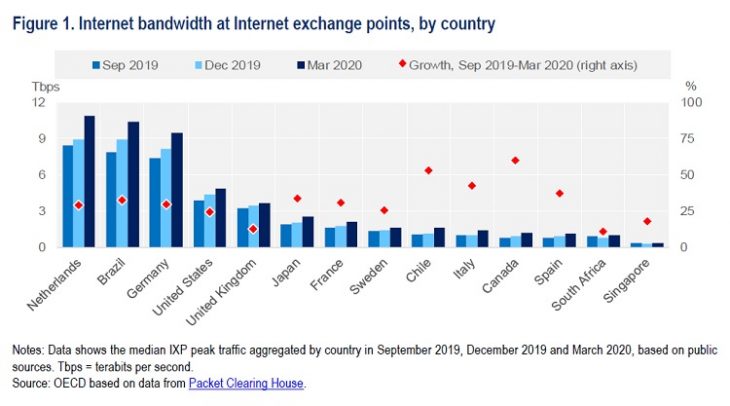
Says more of Canada’s ISPs should peer locally
PARIS — Since the start of the Covid-19 crisis, Internet traffic has jumped by as much 60% through Internet exchange points (IXPs) in OECD countries as a majority of people are now working and studying from home while streaming movies and holding video calls, according to a recent OECD study.
The global study included Canada in its analysis (see chart) but did not break out specific data for the country in the released report. What can be gathered from the chart included in the report is that Canada’s Internet traffic has grown by roughly 60% from September 2019 to March 2020.
Instead the OECD study focused primarily on European countries, noting for example, that Italy, one of the most severely affected countries in Europe, handled 39.9% more bandwidth between December 2019 and March 2020, up from only 1.8% growth in the prior quarter.
In terms of individual IXPs, Frankfurt’s CE-CIX exchange point, one of the largest in the world, now regularly peaks at more than 9.1 terabits per second (Tbps) of data, which equals a simultaneous transmission of up to 2 million high-definition videos. The exchange has seen a 120% increase in videoconferencing traffic since the start of the Covid-19 crisis.
“Two large operators within Canada, for instance, peer at five and three IXPs, respectively, all within the United States, forcing 64% of Canadian domestic traffic to flow across the border through the United States. This greatly increases the costs and network instability experienced by Canadian customers. A lack of direct interconnection negatively affects the overall Internet performance in a country, while increasing costs and risk.”
The study does refer to Canada in a discussion regarding the lack of direct interconnections in some regions of the world. Loads of Canadian data finds interconnections elsewhere.
“In some countries, big communication operators may refuse to interconnect domestically with other networks, forcing smaller networks to send domestic traffic over large distances to IXPs in other countries and back, leading to higher costs and lower quality. Two large operators within Canada, for instance, peer at five and three IXPs, respectively, all within the United States, forcing 64% of Canadian domestic traffic to flow across the border through the United States. This greatly increases the costs and network instability experienced by Canadian customers. A lack of direct interconnection negatively affects the overall Internet performance in a country, while increasing costs and risk,” the study says.
However, despite the surge in Internet traffic around the world, network operators and content providers have been able to successfully maintain services by either efficiently using existing capacity or by adding new capacity, says the study.
The OECD suggests that policy makers and regulators can alleviate congestion in mobile networks by either temporarily releasing additional spectrum or by approving temporary commercial spectrum transactions between providers that would put unused spectrum into service.
“In the medium term, regulators could stimulate broadband providers to deploy more fibre deeper into the networks and gradually phase out xDSL technologies, where possible, and alleviate administrative burdens to ease network deployment,” reads the study.
This study is one of a series of papers available on the OECD’s Coronavirus Hub, which is being updated daily with new data, analysis and recommendations on Covid-related topics ranging from economic impacts to education and social issues.



